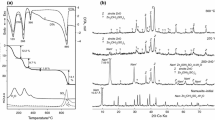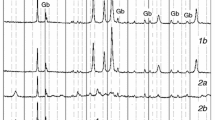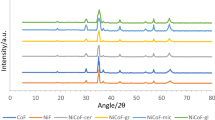Abstract
Thermal decomposition of pure basic zinc carbonate (BZC) and doped or mixed with iron ions were studied using TG, DTA and kinetics of isothermal decomposition. The TG and DTA investigations revealed that, the presence of iron ions retards the decomposition processes of (BZC). Also, the retardation effect increases on increasing of iron concentration up to 50 at.%. The curves of isothermal decomposition show the usual sigmoidal character. The decomposition velocity contsant (K) values are plotted vs. 1/T according to Arrhenius equation gave a plot of good straight lines with activation energies of 43.7, 48.2, 53.2 and 57.1 kJ mol−1 for pure (BZC) and incorporated with 1, 10, 30 and 50 at.% Fe2+ respectively. The products of the thermal decomposition of pure BZC and mixed with iron ions are characterized using X-ray diffraction, IR spectroscopy, surface area determination and the surface porosity. These investigations showed that iron ions are effectively incorporated into zinc oxide lattice in the range of 30–50 at.%, which gave a ZnFe2O4 spinel.
Zusammenfassung
Mittels TG, DTA und der Kinetik der isothermen Zersetzung wurde der thermische Abbau von reinem bzw. von mit Eisenionen versetztem basischen Zinkcarbonat (BZC) untersucht. TG- und DTA-Untersuchungen zeigen, da\ der Zersetzungsproze\ von BZC durch Eisenionen gehemmt wird. Dieser Hemmungseffekt wÄchst bis zu einer Eisenionenkonzentration von 50 mol%. Die Kurven der isothermen Zersetzung zeigen den üblichen sigmoiden Charakter. Aus dem Auftragen der Geschwindigkeitskonstantek des Zersetzungsprozesses (gemÄ\ der Arrhenius-Gleichung) gegen 1/T ergeben sich in guter NÄherung Geraden mit den Aktivierungsenergien 43.7, 48.2, 53.2 und 57.1 kJmol−1 für BZC mit einem Fe+-Gehalt von 0, 1, 10, 30 bzw. 50 mol%. Die thermischen Zersetzungsprodukte von reinem bzw. von mit Eisenionen versetztem BZC wurden unter Zuhilfenahme von Röntgendiffraktion, IR-Spektroskopie, OberflÄchenbestimmung und OberflÄchenporositÄt charakterisiert. Diese Untersuchungen ergaben, da\ Eisenionen im Bereich 30–50 mol% in das Zinkoxidgitter eingebaut werden und dabei ein ZnFe2O4 Spinell entsteht.
Similar content being viewed by others
References
L. Ya. Margolis, Adv. Catal., 14 (1964) 493.
R. W. Maatman, R. Lego and C. D. Partes, Adv. Catal., 9 (1959) 53.
S. Koido, J. Phys. Soc. Jpn., 20 (1965) 123.
G. A. El-Shobaky, N. Sh. Petro and T. M. Ghazy, Surf. Technol. 15 (1982) 33.
R. L. Shin and D. M. Hercules, J. Catal., 74 (1982) 121.
K. M. Abd El-Salaam and E. A. Hassan, Surf. Technol., 11 (1980) 55.
K. M. Abd El-Salaam and K. Hauffe, Ber. Bunssenges Phys. Chem., 83 (1978) 811.
F. Solymosi and Z. G. Szabo, J. Chem. Soc., (1961) 2745.
B. L. Kugler and J. W. Gryder, J. Catal. 44 (1979) 126.
T. Uenatsu, K. Inamura, K. Hirari and H. Hashimoto, J. Catal., 45 (1976) 68.
S. J. Gregg and K.S.W Sing, “Adsorption Surface Area and Porosity” Academic Press, London (1967).
B. C. Lippens and J. H. de Boer, J. Catal., 4 (1965) 319.
J. C. P. Brockhoff and J. H. de Boer, J. Catal., 9 (1967) 5.
Y. Kubokawa, Bull. Chem. Soc. Jpn., 33 (1960) 739.
D. G. Thomas and J. Lander, J. Phys. Chem. Solids, 2 (1957) 318.
G. F. Huttig, Z. Electrochem., 14 (1938) 627.
R. Fricke and W. Durr, Y. Electrochem., 45 (1939) 254.
J. Bereka and M. J. Ridge, Nature (London), 216 (1967) 473.
H. Takei and S. Shiba, J. Phys. Soc. Jpn., 21 (1966) 1255.
J. V. Smith, Ed., “X-ray powder Data File” American Soc. for Testing Materials, Philidelphia (1960).
S. S. Brenner, J. Electrochem. Soc., 102 (1955) 7.
R. M. Moorjani, P. K. Segupta, G. Sengupta and S. P. Sen, Technology 7 (1970) 247.
H. T. S. Britton, S. J. Gregg and G. W. Winsor, Trans. Faraday Soc., 48 (1952) 63.
V. V. Boldyrev, Kinet. Katal., 1(2) (1960) 203.
R. A. Nyquist and R. O. Kagel, “Infrared Spectra of Inorganic Compounds” Academic Press, New York and London (1970).
Author information
Authors and Affiliations
Rights and permissions
About this article
Cite this article
Said, A.A., Hassan, E.A., Abd El-Salaam, K.M. et al. Influence of iron ion additions on the thermal decomposition of basic zinc carbonate. Journal of Thermal Analysis 36, 1331–1345 (1990). https://doi.org/10.1007/BF01914056
Received:
Revised:
Issue Date:
DOI: https://doi.org/10.1007/BF01914056




